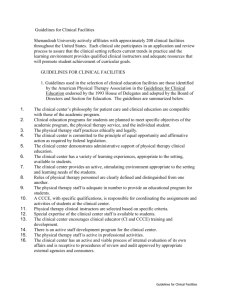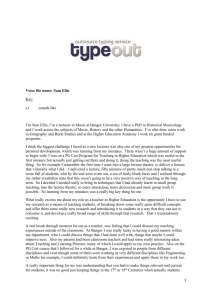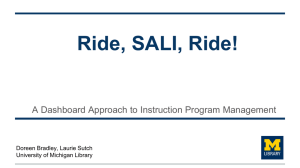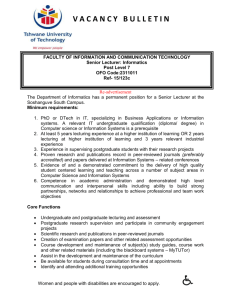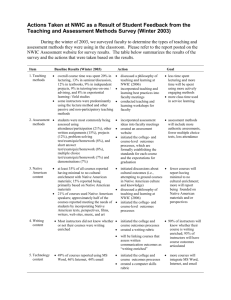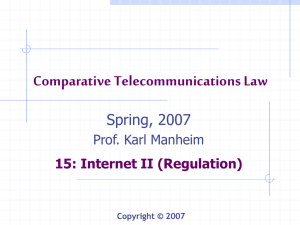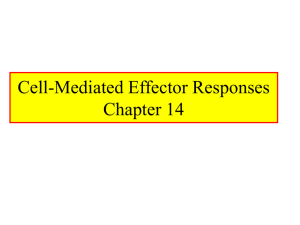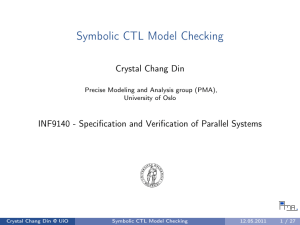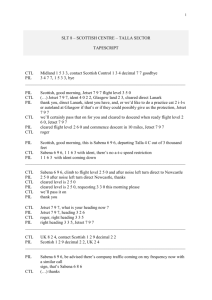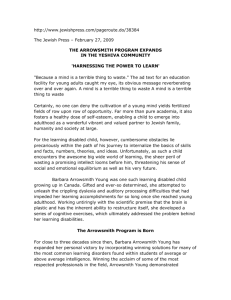Getting Students to Work and Think in the Classroom
advertisement
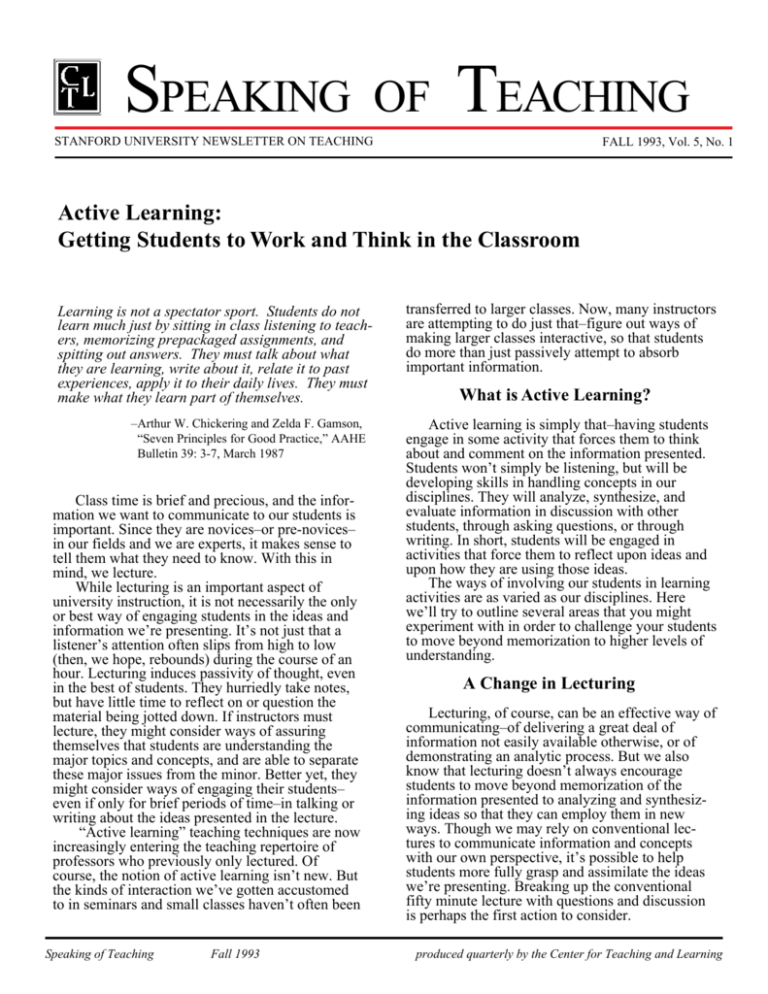
SPEAKING OF TEACHING STANFORD UNIVERSITY NEWSLETTER ON TEACHING FALL 1993, Vol. 5, No. 1 Active Learning: Getting Students to Work and Think in the Classroom Learning is not a spectator sport. Students do not learn much just by sitting in class listening to teachers, memorizing prepackaged assignments, and spitting out answers. They must talk about what they are learning, write about it, relate it to past experiences, apply it to their daily lives. They must make what they learn part of themselves. –Arthur W. Chickering and Zelda F. Gamson, “Seven Principles for Good Practice,” AAHE Bulletin 39: 3-7, March 1987 Class time is brief and precious, and the information we want to communicate to our students is important. Since they are novices–or pre-novices– in our fields and we are experts, it makes sense to tell them what they need to know. With this in mind, we lecture. While lecturing is an important aspect of university instruction, it is not necessarily the only or best way of engaging students in the ideas and information we’re presenting. It’s not just that a listener’s attention often slips from high to low (then, we hope, rebounds) during the course of an hour. Lecturing induces passivity of thought, even in the best of students. They hurriedly take notes, but have little time to reflect on or question the material being jotted down. If instructors must lecture, they might consider ways of assuring themselves that students are understanding the major topics and concepts, and are able to separate these major issues from the minor. Better yet, they might consider ways of engaging their students– even if only for brief periods of time–in talking or writing about the ideas presented in the lecture. “Active learning” teaching techniques are now increasingly entering the teaching repertoire of professors who previously only lectured. Of course, the notion of active learning isn’t new. But the kinds of interaction we’ve gotten accustomed to in seminars and small classes haven’t often been Speaking of Teaching Fall 1993 transferred to larger classes. Now, many instructors are attempting to do just that–figure out ways of making larger classes interactive, so that students do more than just passively attempt to absorb important information. What is Active Learning? Active learning is simply that–having students engage in some activity that forces them to think about and comment on the information presented. Students won’t simply be listening, but will be developing skills in handling concepts in our disciplines. They will analyze, synthesize, and evaluate information in discussion with other students, through asking questions, or through writing. In short, students will be engaged in activities that force them to reflect upon ideas and upon how they are using those ideas. The ways of involving our students in learning activities are as varied as our disciplines. Here we’ll try to outline several areas that you might experiment with in order to challenge your students to move beyond memorization to higher levels of understanding. A Change in Lecturing Lecturing, of course, can be an effective way of communicating–of delivering a great deal of information not easily available otherwise, or of demonstrating an analytic process. But we also know that lecturing doesn’t always encourage students to move beyond memorization of the information presented to analyzing and synthesizing ideas so that they can employ them in new ways. Though we may rely on conventional lectures to communicate information and concepts with our own perspective, it’s possible to help students more fully grasp and assimilate the ideas we’re presenting. Breaking up the conventional fifty minute lecture with questions and discussion is perhaps the first action to consider. produced quarterly by the Center for Teaching and Learning Some lecturers begin class by first having students brainstorm problems that remained unresolved from the previous lecture, or raise questions from the previous lecture or their reading assignment. The lecturer can then address these issues while proceeding with the day’s topic, responding to student input while covering new material. This exercise can be particularly useful if students know in advance that you’ll be asking for their participation at the beginning of the class. Another simple technique to involve students is to pause for a few minutes two or three times during an hour lecture to allow students to consolidate notes and develop questions about the material being presented. Too often we assume that students have understood and carefully noted down all that we’ve covered. But most students need time to organize their notes and think about the material. A short break can help them notice the gaps in their notes or jot down questions uppermost in their minds. Additionally, a lecturer can pause and ask students to work in pairs to organize their notes and discuss the key points of the lecture. Each group could also develop questions based on what they feel is still unclear, and these questions could be addressed in the final minutes of the class or could serve as the starting point for the next lecture. A final effective technique is to have students close their notebooks a few minutes before the end of class and then ask them to reconstruct, on a blank sheet of paper, as much of the lecture as possible–either in outline form or diagrammatically. This exercise in immediate recall forces students to review and consolidate key points, and helps them discover areas for review. Questioning and Discussion Carrying on a discussion with our class seems entirely appropriate when we’re facing 20 or 30 students. But with a hundred or more? Many instructors have found it not only possible, but a valuable component of the course, since students are forced to be alert and feel a greater sense of commitment to the class. Several techniques are possible with large classes: lecture for thirty minutes or so, and spend the final time asking questions that require students to apply what they’ve heard, or analyze it, or relate it to their reading assignments; punctuate lectures with brief questions that require students to explain major concepts with examples or analogies; use one class a week solely for discussion, so that students come prepared to participate. Simply put, most of the techniques we use in seminar discussions can be adapted to work in larger classes. Page 2 Cooperative Learning Group work can be an extremely useful addition to a large class. Not only does peer discussion help students understand and retain material, but it helps them develop better communication skills. Students also become aware of the degree to which other students can be a valuable resource in learning. As many students will say, they know they really understand the subject matter when they must explain it or teach it to a peer. Some instructors break up a lecture by having students divide themselves into groups of three or four and answer specific questions, or solve specific problems. Each group appoints a spokesperson who may have to report on the group’s progress, once the larger class reconvenes. It’s not necessary to call on every group for a response–a general sense of the class’s understanding can be gained by quickly polling several groups for their questions or comments. Group work can also be used on a more formal scale. Students can be divided into groups early in the quarter, and encouraged to share phone numbers and addresses. Then specific group projects can be assigned that require groups to meet outside of class. Groups might be responsible for starting discussion, for presenting important concepts, or reporting on research. To generate discussion, groups can be told to research a complex issue and in class be asked to represent a specific position in an impromptu debate. Role Plays and Case Studies Like debates, role plays and simulations require students to place themselves in a particular situation or take a committed position on a key issue in the course. For example, students might become players in an historical event, one requiring they research positions and argue for certain actions or decisions. In scientific fields, students can become actual representatives of a physical process, acting it out to make it more concrete. More structured than role plays, case studies are stories, often based on real world examples, that place students in the role of decision maker. They contain the data students need to make sense of the situation, but don’t usually contain analysis or conclusions. Students must make sense of the information and come to appropriate conclusions regarding the next actions to take, or the kind of data they will need in order to come to an appropriate conclusion. Case studies thus test students’ analytic and problem solving approaches while making them conscious of how to use the skills they’ve been developing in the class. We tend to think of legal or business training as largely dependent on case study, but often ignore the fact that the case method is easily adapted to many Speaking of Teaching Fall 1993 A Classification of Instructional Stategies According to Students’ Activity and Risk Involved Students Are Active/Lower Risk Students Are Active/Higher Level of Risk Structured small-group discussion Surveys or questionnaires Demonstrations Self-assessment activities Brainstorming activities In-class writing Field trips Library tours Quizzes or examinations Lecture with pauses Lecture with discussion Feedback Lecture Role playing Small-group presentations Presentations by individual students Guided imagery exercise Unstructured small-group discussion Responsive lecture Students Are Inactive/Lower Level of Risk Students Are Inactive/Higher Level of Risk Show a film for the entire class period Lecture for an entire period Invite a guest lecturer of unknown quality From Charles C. Bonwell and James A. Eison, Active Learning: Creating Excitement in the Classroom, ASHE-ERIC Higher Education Report No. 1. Washington, D.C.: The George Washington University, School of Education and Human Development, 1991 disciplines–it is, after all, what we as professionals in a field actually encounter in our own work. What can make case study a powerful teaching device is the clear sense that this could indeed be a situation you or a colleague has encountered, and that there may be several ways of assessing the situation in order to find a reasonable solution. Indeed, the ambiguity inherent in many cases sparks discussion that forces students to weigh the credibility and validity of arguments and reasoning. Barriers to Active Learning While the activities described here might seem appealing, they often seem appealing for other instructors or other disciplines–but not for our own. That is, a certain amount of internal resistance sometimes sets in. Trying new activities might seem like inviting disaster, especially when it means giving up the control that a lecturer commands. And there is always the pressure to cover more and more material, so that activities involving students–activities taking up classroom time–seem wasteful. There is also a kind of institutional pressure not to experiment with our teaching, since any experimentation takes thinking about–thereby taking time away from our research and writing. Incentives and even Speaking of Teaching Fall 1993 collegial support to improve or alter our teaching are often nonexistent. And also, of course, is the fear of trying something new and failing–a fear of taking risks in the classroom. Despite the fact that trying new teaching methods can feel uncomfortable, instructors who are using active learning in their large classes believe it makes a difference and is worth experimenting with. Without truly sacrificing breadth of coverage, we are able to increase depth of understanding, since students must engage with the material we’re presenting and immediately attempt to use it, not just note it down for future thought. Getting your students involved in activities in the classroom also requires them regularly to assess their own degree of understanding and skill at handling concepts or problems in your discipline. Rather than allowing them to rest comfortably with a surface knowledge, it forces them to develop a deeper understanding. As a result, students are much more likely to study carefully, to regularly note their own questions or difficulties with assignments. Such students are also more likely to prepare in a consistent way for exams, not waiting until the last minute with difficulties or concerns. In short, active learning in the classroom offers significant benefits both to you and your students. Page 3 CTL TA CONSULTANTS CTL consultants are graduate students with successful TA experience and special training in discussing teaching and learning problems. If you are a TA, you’ll meet one of them, or a member of our staff, when you request a videotape session or a quick, in-class evaluation. Jehanne Anabtawi Bari Anholt Ramon Arrowsmith Derede Arthur Angela Bakker Hanya Chrispeels Marcelo Clerici-Arias Sean Decatur Sanford Dickert Scott Dudley Donna Fortier Mark Gonnerman Rafael Guzman Tanya Kalich Dennis Kinsey Traci Mann Chris Manning Lance Miller Max Moerman Linda Price Sandra Razieli Renee Romano Jackie Scott Eric Schocket Keith Todd Mark Unno Linda Zimmerman Philosophy Political Science Earth Sciences English Human Biology Biology Economics Chemistry Electrical Engineering English French Religious Studies Petroleum Engineering Mathematics Communication Psychology Linguistics Drama Religious Studies Industrial Engineering Anthropology History Philosophy English English Religious Studies Art CTL TA LIAISONS CTL liaisons are TAs nominated by their departments to help acquaint their TAs, faculty, and lecturers with CTL’s services and other teaching resources on campus. Contact your department liaison if you want more information. Aero-Astro Anthropology Art Asian Languages Biology Chemistry Classics Economics Electrical Engineering English Civil Engineering Communication Drama Feminist Studies French and Italian Geology Geophysics History Human Biology Industrial Engineering Linguistics Mathematics Petroleum Engineering Philosophy Political Science Psychology Religious Studies Slavic Languages Sociology Sally Gressens Sandra Razieli Linda Zimmerman Elizabeth Moreno Manish Raizada Tami Westre Phiroze Vasunia Marcelo Clerici-Arias Vincent Mooney Tim Wandling Sara Wadia Dennis Kinsey Lance Miller Jeannie Alcouloumre Susan Bree Ramon Arrowsmith Marian Magee Renee Romano Angela Bakker Michelle Baron Christopher Manning Tanya Kalich Santosh Verma Jehanne Anabtawi Bari Anhalt Traci Mann Max Moerman Judy Kalb Liz Boyle Consultations for Faculty Members Are Available at CTL Contact Michele Marincovich, Director or Jack Prostko, Associate Director 723-1326 Page 4 Speaking of Teaching Fall 1993
